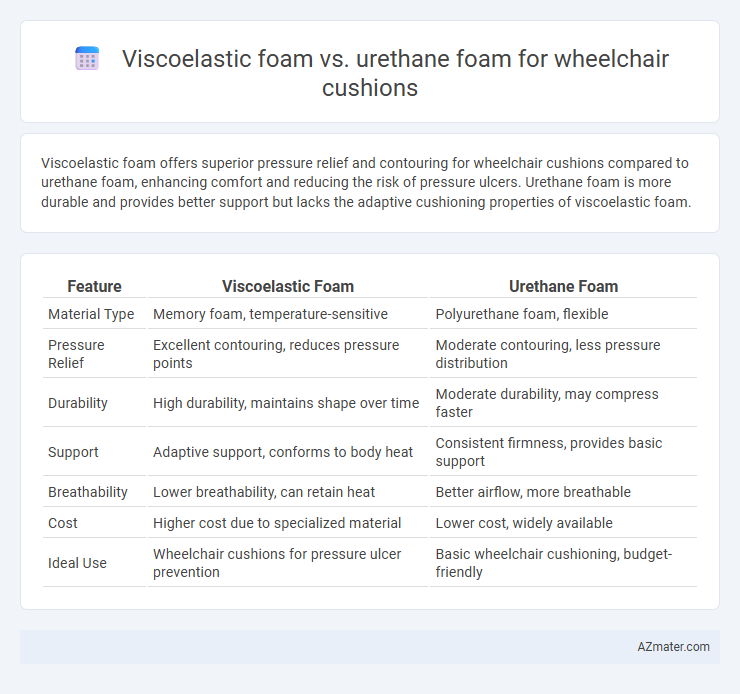Viscoelastic foam offers superior pressure relief and contouring for wheelchair cushions compared to urethane foam, enhancing comfort and reducing the risk of pressure ulcers. Urethane foam is more durable and provides better support but lacks the adaptive cushioning properties of viscoelastic foam.
Table of Comparison
| Feature | Viscoelastic Foam | Urethane Foam |
|---|---|---|
| Material Type | Memory foam, temperature-sensitive | Polyurethane foam, flexible |
| Pressure Relief | Excellent contouring, reduces pressure points | Moderate contouring, less pressure distribution |
| Durability | High durability, maintains shape over time | Moderate durability, may compress faster |
| Support | Adaptive support, conforms to body heat | Consistent firmness, provides basic support |
| Breathability | Lower breathability, can retain heat | Better airflow, more breathable |
| Cost | Higher cost due to specialized material | Lower cost, widely available |
| Ideal Use | Wheelchair cushions for pressure ulcer prevention | Basic wheelchair cushioning, budget-friendly |
Introduction to Wheelchair Cushion Materials
Viscoelastic foam, also known as memory foam, offers superior pressure distribution and contouring by responding to body heat and weight, making it ideal for wheelchair cushions designed to prevent pressure ulcers. Urethane foam provides a firmer support with greater durability and resilience, often preferred for users requiring enhanced stability and longer-lasting cushions. Selecting the appropriate material depends on balancing comfort, pressure relief, and maintenance needs for optimal wheelchair user support.
What is Viscoelastic Foam?
Viscoelastic foam, often referred to as memory foam, is a high-density polyurethane material infused with viscoelastic polymers that respond to body heat and pressure, providing superior contouring and pressure relief for wheelchair cushions. Its unique cell structure allows slow recovery, enhancing comfort and reducing pressure points, which is crucial for preventing pressure ulcers in wheelchair users. Compared to standard urethane foam, viscoelastic foam offers improved durability, enhanced support, and better risk reduction for skin breakdown.
What is Urethane Foam?
Urethane foam, a versatile polymer material, is widely used in wheelchair cushions for its lightweight and durable properties. Its cellular structure provides firm support and resilience, helping to distribute pressure evenly and enhance comfort for prolonged sitting. Compared to viscoelastic foam, urethane foam offers faster response time and better breathability, making it suitable for users requiring active pressure management and moisture control.
Pressure Distribution: Viscoelastic vs Urethane
Viscoelastic foam offers superior pressure distribution by conforming closely to the body's contours, reducing localized pressure points critical for wheelchair users at risk of pressure ulcers. Urethane foam tends to provide firmer support but can concentrate pressure on bony prominences, potentially increasing discomfort during prolonged sitting. Optimal wheelchair cushions often incorporate viscoelastic foam layers to enhance pressure relief and promote skin integrity.
Comfort and Support Levels Compared
Viscoelastic foam wheelchair cushions provide superior pressure distribution and conform closely to body contours, enhancing comfort and reducing pressure sores risk. Urethane foam offers firmer support with greater durability but may sacrifice some softness and adaptability, potentially resulting in increased pressure points during extended use. Selecting between these foams depends on individual comfort preferences and required support levels for optimal wheelchair seating ergonomics.
Durability and Longevity of Both Foams
Viscoelastic foam offers superior durability and retains its shape longer under constant pressure, making it an ideal choice for wheelchair cushions requiring prolonged use. Urethane foam tends to compress faster over time, leading to reduced support and the need for more frequent replacement. The inherent cell structure of viscoelastic foam resists wear and breakdown better, ensuring enhanced longevity compared to traditional urethane foam options.
Temperature Sensitivity and Breathability
Viscoelastic foam, known for its temperature sensitivity, softens with body heat to provide customized pressure relief, enhancing comfort in wheelchair cushions. Urethane foam maintains consistent firmness regardless of temperature, offering stable support but less adaptability to body heat fluctuations. In terms of breathability, urethane foam generally allows better airflow due to its open-cell structure, while viscoelastic foam's denser composition can trap heat, potentially reducing ventilation and increasing moisture retention.
Weight and Portability Factors
Viscoelastic foam offers superior weight distribution but tends to be heavier and less portable compared to urethane foam, which is lighter and easier to transport. Urethane foam cushions provide enhanced portability for wheelchair users who frequently travel or need lightweight support. Selecting the appropriate foam depends on balancing pressure relief needs with weight and portability requirements.
Cost Comparison and Value for Money
Viscoelastic foam wheelchair cushions generally cost more than urethane foam options due to their advanced pressure-relief properties and superior durability. Urethane foam is less expensive initially but tends to compress faster, reducing its lifespan and potentially increasing long-term costs. When evaluating value for money, viscoelastic foam offers enhanced comfort and extended support, making it a more cost-effective choice for users requiring consistent pressure redistribution.
Which Foam is Best for Wheelchair Users?
Viscoelastic foam, also known as memory foam, offers superior pressure relief and contours closely to the body, reducing the risk of pressure ulcers for wheelchair users compared to urethane foam. Urethane foam provides firmer support but may lack the adaptive comfort and pressure distribution benefits essential for long-term wheelchair cushion use. For optimal pressure management and comfort, viscoelastic foam is often considered the best choice for wheelchair cushions.

Infographic: Viscoelastic foam vs Urethane foam for Wheelchair cushion
 azmater.com
azmater.com